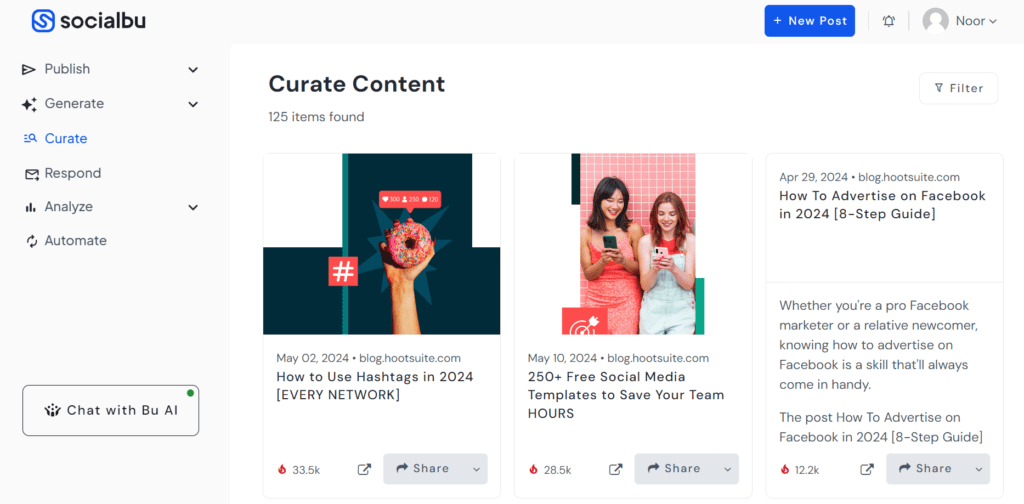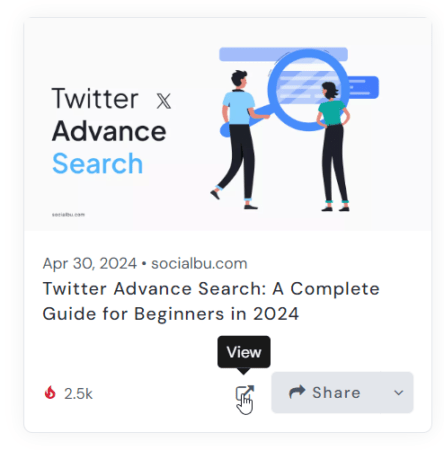In today’s digital age, we’re constantly bombarded with information. What is content curation, and how can it be a valuable tool? Content curation is finding, selecting, and sharing high-quality content that resonates with your target audience.
It’s more than just mindlessly sharing links. It’s about becoming a trusted source by providing valuable insights and perspectives on the content you curate.
This blog post will discuss content curation, its benefits, the process involved, and best practices for effectively curating content.
Introduction To Content Curation
Content curation is the systematic process of discovering, collecting, organizing, and sharing relevant and valuable content created by others.
It involves sifting through the vast amount of information available online, identifying the most relevant and high-quality content, and presenting it clearly and concisely to meet the needs of a specific audience.
What Is Content Curation?
Content curation is about adding value to existing content by contextualizing it, making it more accessible, and providing additional insights or perspectives.
It requires a deep understanding of the target audience, their interests, and their pain points. By curating content, individuals and organizations can position themselves as trusted sources of information, build credibility, and establish thought leadership in their industry.
Why Is Content Curation Important?
When we ask ourselves, “What is content curation, and why is it important?” The answer is clear. Content curation is vital for anyone looking to establish credibility, build trust, and drive engagement in today’s digital landscape.
In today’s digital age, the sheer volume of online information can be overwhelming. The average person spends 2 hours and 23 minutes daily on social media, equating to 35.8% of their daily internet activity.

This constant barrage of information can be difficult to navigate, making finding reliable sources and trustworthy perspectives crucial.
Content curation helps to filter out the clutter, identify the most relevant information, and present it in a way that resonates with the target audience.
Content curation plays a crucial role in addressing information overload, making it easier for people to find what they need when they need it.
Benefits of Content Curation
Content curation in marketing plays a vital role in today’s digital landscape. Here’s how it can significantly boost your strategy.
The Role Of Content Curation In Content Marketing Strategies
Content curation plays a vital role in content marketing strategies. It provides a cost-effective and efficient way to supplement original content creation efforts.
In fact, 82% of marketers have added content curation to their marketing strategy to showcase themselves as experts in their industry and reinforce their relationships with the audience.

By curating content, you can fill gaps in your content calendar, provide fresh perspectives, and showcase your brand’s expertise and thought leadership.
How Content Curation Can Enhance Your Social Media Presence
Content curation can significantly enhance your social media presence by providing a steady stream of high-quality content that resonates with your audience.
76% of marketers share and distribute curated content on social media. You can increase engagement, drive traffic, and build a loyal following by sharing curated content.
The Value Of Curated Content For Your Target Audience
Curated content offers immense value to your target audience by providing them with relevant, timely, and trustworthy information.
By curating content, you can help your audience stay up-to-date with industry trends, insights, and best practices.
This, in turn, can establish your brand as a trusted source of information, build trust and credibility, and drive long-term loyalty.
Incorporating content curation in marketing can significantly impact your content marketing efforts. By leveraging curated content, you can supplement your original content creation, enhance your social media presence, and provide value to your target audience.
Content Curation Process
Content curation is a strategic process ensuring you deliver high-quality content to your audience.

Here’s a breakdown of the key steps involved:
How To Curate Content Effectively
While there are many approaches, effective content curation boils down to a few key principles.
1. Understand
Identify your audience’s needs and interests to curate content that resonates with them.
2. Source
Set up a system to collect relevant content from various sources, such as newsletters, social media, and news outlets.
3. Evaluate
Assess the quality and relevance of the content based on your audience’s needs and preferences.
4. Publish
Present the curated content meaningfully and engagingly, using context and tags to enhance its value.
5. Maintain
Regularly update and refresh your curated content to remain relevant and fresh.
6. Analyze
Monitor the performance of your curated content to understand what works and what doesn’t, and adjust your strategy accordingly.
7. Content curation AI
Content curation by AI tools can be helpful throughout this process. They can help you discover relevant sources, analyze content for quality, and even automate some processes for sharing the content.
However, AI shouldn’t replace human judgment. Maintaining a critical eye and ensuring the curated content aligns with your overall strategy is important.
Steps For Finding And Selecting Relevant Sources
Finding quality sources is the foundation of effective content curation. Here are some steps to follow.
- Identify relevant websites and publications in your industry. Look for reputable sources known for their expertise.
- Follow industry leaders and influencers on social media. They often share valuable content and insights.
- Leverage online tools and subscriptions. Many services can help you discover relevant content based on your keywords and interests.
- Don’t forget about traditional sources. Industry reports, academic journals, and white papers can be valuable resources.
The Importance Of Reliable Sources In Content Curation
The credibility of your curated content hinges on the quality of your sources. Sharing information from unreliable sources can damage your reputation and mislead your audience. Always prioritize accuracy and trustworthiness when selecting content.
Tips for Organizing and Categorizing Curated Content
Organizing and categorizing your curated content is crucial for making it easily accessible and consumable. Here are some tips.
- Use tags: Use relevant tags and keywords to categorize your content.
- Create categories: Organize your content into categories and subcategories.
- Use summaries: Provide brief summaries or introductions to contextualize the curated content.
- Use visuals: Use images, videos, or infographics to make the content more engaging and shareable.
- Make it searchable: Ensure your curated content is searchable, making it easy for your audience to find what they need.
Types of Content for Curation
The beauty of content curation lies in its versatility. You can curate a wide range of content to cater to your audience’s needs.
Here are some popular types to consider.
1. Educational Content: Sharing Valuable Information And Resources
What is content curation in education? It’s a powerful tool for educators to provide students with diverse learning materials.
By curating educational content like articles, videos, and interactive resources, educators can
- Provide supplementary resources for students.
- Enhance the learning experience.
- Encourage critical thinking and analysis.
- Foster collaboration and knowledge-sharing
This approach keeps students engaged and exposes them to various perspectives on a topic.
Content curation vs content creation goes hand-in-hand in education. Educators can curate high-quality content while creating original materials like quizzes, assignments, and discussions to guide student learning.
2. Industry News and Trends: Keeping Your Audience Informed and Updated
Staying up-to-date with industry news and trends is crucial for businesses and professionals. Content curation helps by
- Identifying relevant news and updates
- Filtering out noise and irrelevant information
- Providing context and analysis
- Enabling informed decision-making
3. Curated Lists: Providing Comprehensive Content on Specific Topics
Curated lists offer a fantastic way to present a variety of resources on a single theme.
For example, you could create a list of the top 10 blog posts on social media marketing or a collection of infographics on healthy eating.
It gives your audience a one-stop shop for valuable content on their interests.
Examples of Successful Content Curation Initiatives
- Medium’s Top 100: A curated list of the best articles on Medium
- The Skimm: A daily newsletter curating news and updates for young professionals
- Product Hunt: A platform curating new and innovative products
- TED Talks: Curated talks on various topics, providing valuable insights and knowledge
By understanding the different types of content curation, you can effectively leverage this strategy to support your goals, whether in education, business, or personal development.
Content Curation Metrics
Just like any marketing strategy, measuring the success of your content curation efforts is crucial. Content curation tools can be valuable assets in this process, offering data and insights to help you refine your approach.
1. Tracking The Effectiveness Of Your Content Curation Efforts
You need real-time and standardized metrics to track your content curation efforts. Content curation tools like SocialBu and Curata provide analytics and insights to help you measure your success.
Some key metrics to track include:
2. Website Traffic
Does your curated content attract new visitors to your website or social media channels?
3. Engagement
Are people liking, sharing, and commenting on your curated content? High engagement indicates that your audience finds the content valuable and interesting.
4. Click-through rates (CTR)
How many people are clicking on the links you share in your curated content? A high CTR suggests your audience is interested in learning more about your curated topics.
5. Lead generation
Is your curated content helping you generate leads or sales? For example, are people signing up for your email list or contacting you after consuming your curated content?
6. Real-time And Standardized Metrics For Content Curation
Many social media platforms and content management systems offer built-in analytics tools that provide real-time data on your content’s performance.
These tools allow you to track metrics like impressions, reach, and engagement for each piece of content you curate and share on your social media platforms.
This real-time feedback helps you understand what resonates with your audience and adjust your strategy accordingly.
Standardized metrics ensure consistency in tracking your content curation efforts. For example, focusing on a specific set of metrics across all platforms allows you to compare the performance of your curated content on different channels.
7. Improving Content Curation Based On Data And Insights
The data and insights you gather from tracking your content curation metrics are invaluable for improvement.
By analyzing this data, you can.
- Identify the types of content that resonate most with your audience.
- Refine your sources for curated content.
- Optimize your content curation schedule and posting times.
- Develop a more targeted content curation strategy that aligns with your audience’s interests.
By continually tracking and analyzing your content curation metrics, you can ensure that your efforts deliver the best possible results for your audience and your business goals.
Curate Content With SocialBu
Finding reliable tools to curate content is great, but being able to plan, publish, or schedule that content directly is the cherry on top.
In three easy steps, you can easily curate content with SocialBu on any topic related to your niche.
- Login to the SocialBu app and navigate to the “Curate” option on the left side of the panel.
- Click on “Filter” and add the keyword on which you want to curate the content and the time limit.
- Click “Apply”. You will have all the news, articles, and latest updates about that topic or keyword.

Now comes the part where you can publish and schedule the curated content.
- Suppose this is the article you like when you use content curation with SocialBu.

- You can click on it and share it directly to your social media handles that are added on SocialBu.
- You can edit the post to generate a similar one with the SocialBu AI feature.

This means your audience can experience something new and unique every time. Then, using the “Analyze” feature, you can track the metrics of the curated content you posted.
In conclusion, SocialBu offers the complete experience of content curation, content publishing, and content analytics in one place.
Best Practices for Content Curation
Content curation in marketing is a powerful tool, but it’s important to implement it strategically. Here are some best practices to ensure you get the most out of your content curation efforts.
1. Balancing Original Content Creation and Curated Content
Effective content curation in marketing involves striking a balance between original content creation and curated content. By combining both, you can:
- Showcase your brand’s voice and expertise through original content
- Supplement your content calendar with relevant and valuable curated content
- Provide a comprehensive and diverse content experience for your audience
2. Avoiding Plagiarism and Giving Credit to Original Sources
When curating content, it’s essential to avoid plagiarism and give credit to sources. This includes:
- Quoting and citing original authors and sources
- Using proper attribution and linking to original content
- Ensuring that curated content is transformative and adds value
3. Developing a Content Calendar for Curated Content
A content calendar helps you plan and organize your curated content. You can
- Schedule curated content in advance
- Have proper themed content days or weeks
- Mix curated content with original content
4. How To Share Curated Content Across Social Media Platforms
Social media is a fantastic platform for sharing curated content. However, remember that different platforms cater to different preferences.
You should tailor your approach for each platform:
- Twitter: Keep it concise and visually appealing. Use relevant hashtags to increase reach.
- LinkedIn: Focus on professional and industry-related content. Share longer articles and infographics.
- Facebook: Engage your audience with questions and discussions prompted by the curated content.
- Instagram: Use high-quality visuals and leverage Instagram Stories to share curated snippets.
By following these best practices, you can ensure your content curation efforts are effective, informative, and engaging for your audience.
Conclusion
In today’s digital landscape, understanding what is content curation and how to leverage it effectively is crucial for businesses and individuals alike. You can establish thought leadership, build trust, and drive engagement by curating high-quality content.
Remember, content curation is not a replacement for original content creation but a complementary strategy to enhance your content marketing efforts.
Now that you have a firm grasp of content curation, take action and put it into practice.
SocialBu is a social media management platform that can streamline your content curation workflow. Schedule your curated posts, track their performance across various platforms, and gain valuable insights within a user-friendly interface.
Sign up for a free trial of SocialBu today and discover how content curation can take your social media marketing to the next level.
FAQs
1. What are the three pillars of content curation?
The three pillars of content curation are:
- Finding and selecting relevant content
- Organizing and categorizing content
- Sharing and presenting content in a meaningful way.
2. What is content curation for beginners?
Content curation for beginners involves finding, selecting, and sharing relevant and valuable content created by others to provide value to your audience and establish your brand as a trusted source.
3. What is curation in SEO?
Curation in SEO involves collecting, organizing, and sharing high-quality content to improve search engine rankings, drive traffic, and increase engagement.
4. What are examples of curation?
Examples of curation include news aggregators like Google News, social media platforms like Pinterest and Instagram, and content discovery platforms like Medium and LinkedIn Pulse.
5. How do I create curated content?
To create curated content, identify your audience’s needs, find relevant content, organize and categorize it, and share it meaningfully, providing context and adding value.
6. What is the most common form of content curation?
The most common form of content curation is social media sharing, where users share relevant and valuable content with their followers, often with added context or commentary.







